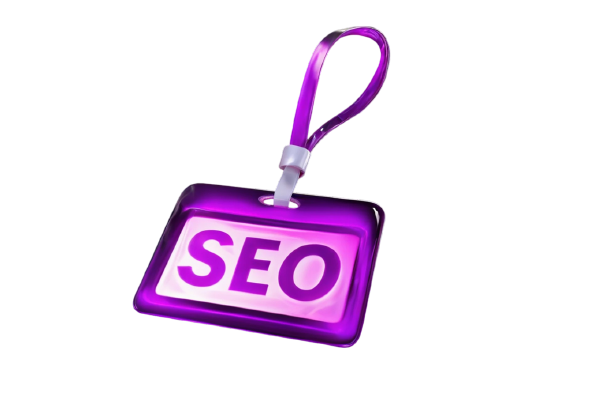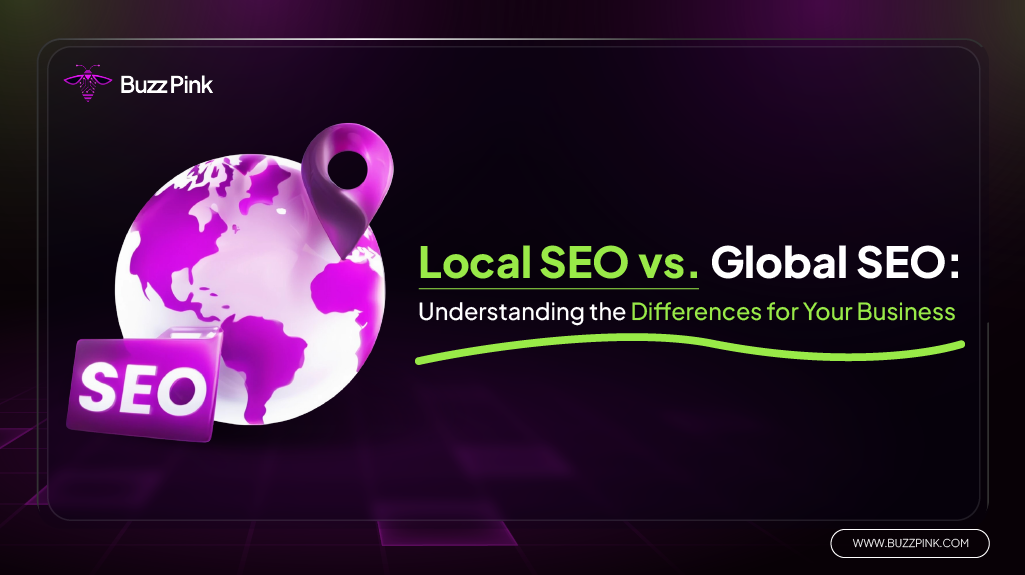We are all aware that SEO is an effective strategy for website optimization. However, SEO is capable of much more than that. Knowing about your target audience is important to maximizing the value of SEO. Identifying SEO specialty differences, such as local SEO vs. global SEO, can help you choose a more appropriate approach for your business.
A small business and an established business have different approaches, even though both may require SEO assistance. Aside from the size of the business, what it offers is also important to consider when deciding which approach is best for you. Whether you want to reach a local or global audience, you must understand the differences between local SEO vs. global SEO.
The Differences of Local SEO vs. Global SEO
 Local SEO targets customers in a specific geographic area, so key strategies include integrating location-based keywords, creating a Google business profile, and gathering local reviews. Small to medium-sized businesses (SMEs), such as the nearby handmade jewelry store, would benefit from a local SEO strategy.
Local SEO targets customers in a specific geographic area, so key strategies include integrating location-based keywords, creating a Google business profile, and gathering local reviews. Small to medium-sized businesses (SMEs), such as the nearby handmade jewelry store, would benefit from a local SEO strategy.
Read More: How to Integrate SEO and User Experience for Better Website Performance
Meanwhile, global SEO focuses on reaching an international audience by creating multilingual content, conducting global keyword research, and tailoring content to each country’s specific culture and language. This strategy is suitable for global or established technology businesses, as they require a much broader approach, such as global SEO.
SEO is essential for online visibility and success, regardless of the size of your business. However, you should decide on a strategy that is in line with your business objectives. Do you want to dominate the local market or expand internationally? This is where understanding the distinction between local SEO vs. global SEO becomes critical.
Key Components of Local SEO Strategy
 Local SEO is more than just about popping up in “nearby SME businesses” search results. To truly excel in the local market, you must delve deeper into advanced strategies. This includes optimizing your Google Business Profile, targeting hyperlocal keywords, creating location-based content, and earning backlinks from trusted local sources.
Local SEO is more than just about popping up in “nearby SME businesses” search results. To truly excel in the local market, you must delve deeper into advanced strategies. This includes optimizing your Google Business Profile, targeting hyperlocal keywords, creating location-based content, and earning backlinks from trusted local sources.
-
Maximize Your Google Business Profile (GBP)
Google Business Profile, previously known as Google My Business, is the backbone of local SEO. It’s more than just a place to enter your name, address, and hours of operation. It’s a valuable asset in your local SEO strategy, with a significant impact on whether or not customers find your company in search results.
The more complete and active your profile is, the more likely Google will include your business in local search results such as Google Maps or the “Local Pack” (the top three results in a local search). You should complete all available elements, including relevant business categories, high-quality photos, and excellent customer service.
Attributes, posts, and Q&A are often overlooked but can have a significant impact on a listing. Attributes can display important information such as disability-friendliness and digital payment options.
Posts, on the other hand, allow you to share your most recent promotions, local events, and important announcements.
Q&A allows you to publicly answer common customer questions while also sending Google a positive signal that your company is active and responsive. Every aspect of this guarantees that you stand out from competitors who can only offer the bare minimum.
-
Create Hyperlocal Content
Hyperlocal content entails targeting keywords and topics that are highly specific to a given area. Not just “East Region Singapore cafes,” but more specific, like “Bedok cafes that stay open until 12 a.m.” This is ideal for businesses that serve a specific area because it addresses a genuine need for local and action-oriented searches. These searches have a high purchase intent because users want immediate solutions in their area.
You can carry out this strategy by creating a separate landing page for each service area. For example, if you own a cafe in the East Region, you can set up separate pages for “Cafe in Bedok” and “Cafe in Changi.” The content can include information about the advantages of your cafe in that area, testimonials from local customers, and even exclusive promotions for residents of that area. Google will interpret these local signals and is more likely to display your page to users in relevant locations.
-
Use Markup Scheme
Schema markup is an additional code on your website that teaches search engines more details about the content of your page. Using specific markup, such as local business, event, or review, helps Google understand that your site is relevant for local searches. This can improve your search results by adding elements like star ratings, addresses, hours, and even prices. All of this can lead to an increase in clicks.
Furthermore, using schema increases your chances of appearing in rich snippets, which are sections of search results that stand out more than regular results. For example, if you have a special event in your neighborhood, such as a weekend BOGO sale, the event schema can instruct Google to display it only to users in your area. Schema also aids in voice search because Google better understands the structure of the information you’re providing.
-
Develop Solid Local Backlinks
Backlinks from other websites to your site are a major factor in SEO rankings. The most valuable backlinks for local SEO derive from locally relevant sources. Local news sites, business directories, community organizations, and blogs focusing on a specific area are all examples. Links from these sites give Google a strong indication that your company has a direct connection to the local community.
Local backlinks can be built using a variety of methods. Sponsoring community events, hosting charity events, and creating content in collaboration with local influencers are all effective strategies. Furthermore, reviews or testimonials from other businesses you support, as well as articles in local media that mention your company, can be valuable sources of backlinks. Remember that you are looking for more than just quantity, including relevance and local authority in the links.
-
Augmented Reality Technology
Augmented reality (AR) in local SEO may seem futuristic, but many businesses are already using it to improve user engagement and experience. A cosmetic brand, for example, could use a try-on feature to display a lipstick shade on a user’s lips, while a real estate company could offer a 360-degree tour of a building. This technology can be integrated into a website or business profile to improve engagement and conversion rates.
AR-based experiences can be a standout feature for local SEO. When users search for “best apartments with 24/7 gym in Changi” and see that your company provides a virtual tour that can be accessed directly from the search results, it will increase clicks and create a modern and professional image. It can also improve user engagement metrics such as visit time and bounce rate, both of which are positive indicators for Google’s local search rankings.
-
Active on Local Social Media
Social media isn’t just for promotion, it also sends local SEO signals to Google. When you actively engage with local audiences on platforms such as Instagram, Facebook, and TikTok, you leave a digital footprint that indirectly boosts your local presence. Social media can also drive traffic to your website, particularly if you share local content like community news, area-specific promotions, or collaborations with other local businesses.
Collaboration with micro-influencers or community leaders can also be very beneficial. They have a loyal and local subscriber base, making their promotions more personal and relevant. Responding to comments and reviews on social media helps you manage your online reputation as well. These social signals may not be direct ranking factors, but they improve your brand’s image and can have a significant impact on customer trust and purchasing decisions.
-
Use the Hreflang Tag
In a bilingual or multilingual region like Singapore, having a website in only one language can be inconvenient for the user. This is where hreflang tags are useful. These tags tell Google the appropriate language version of a page to display to its visitors based on their language and geographical area of residence. For example, Malay-speaking users in Singapore will be directed to the Malay-language page, whereas Mandarin users will still see the Chinese version.
In addition to improving user experience, hreflang eliminates duplicate content in multiple language versions, which can harm SEO rankings. With proper implementation, Google will index the page correctly and display the most relevant version based on language signals. This is also essential to remaining competitive in a market with a strong international community.
Key Components of Global SEO Strategy
Global SEO isn’t just about translating your website and hoping it ranks worldwide. To truly connect with international audiences, you need a deeper, more strategic approach. This includes understanding regional search behaviors, adapting to local cultural nuances, and maintaining brand consistency across languages and markets. Success in global SEO comes from combining technical precision with localized content strategies.
-
Maintain Brand Consistency
When playing on a global scale, brand consistency is essential. Big brands like Nike and Adidas are known for their ability to maintain a consistent identity around the world. Their colors, logos, and core values remain intact, allowing customers from any region to recognize and trust them.
Maintaining brand consistency in global SEO entails ensuring that the voice and style of the language used in your content reflect your brand values even after it has been translated or localized into several languages.
However, consistency must be balanced with localization. Content that works in one country may be irrelevant in another. Adidas’ Sumatra edition promotional campaign, for example, performed incredibly well in Indonesia.
In terms of SEO, this means that each local page should include culturally relevant content while maintaining brand alignment. This can be accomplished by hiring a local content team or professional translators who understand local cultural nuances while adhering to core brand guidelines.
-
Adhere to International Regulations
One of the most difficult challenges in global SEO is adhering to each country’s laws and technology policies. Each country has its own data privacy laws, search engine preferences, and technical limitations.
Some countries require you to provide full transparency about how user data is collected and used. This includes cookie consent features, clear privacy policies, and secure data management systems.
As a result, when developing a global SEO strategy, you must not only optimize your content and keywords but also fully understand and adapt to the legal and technical frameworks of each region.
-
Develop International Backlinks
The more high-quality sites that link to your website, the more likely Google will think it is credible and worthy of a higher ranking. However, in the context of global SEO, these backlinks should originate from geographically and linguistically relevant sites.
For example, if you want to increase your visibility in the Singapore market, backlinks from local Singapore media, Singapore businesses, or Singapore-based blogs will be far more powerful than links from US sites.
A strategic approach is also required to support backlinks. You can collaborate with local media, influencers, or other businesses in the same industry to create content or product reviews. Furthermore, you can target industry publications or community forums in your desired country.
Remember that Google considers not only the number of links but also their quality and context. So, the backlinks you receive should reflect local relevance, both in terms of content and target audience. This will help you build a more organic presence in new markets.
-
Keep Up with the International Trend
AI-driven search personalization is currently one of the most popular trends. This means that users’ search results will become more tailored to their location, search history, device type, and internet usage patterns. As a result, global SEO cannot be based solely on a static strategy. To remain relevant in international markets, algorithms must be constantly monitored and rapidly adapted.
For example, in many developing countries, the majority of internet users use mobile phones rather than desktop computers. This means you must ensure that your website is mobile-friendly, quick to load, and looks good on small screens. This type of adaptation allows your website to compete effectively in a variety of global markets with distinct search characteristics.
When to Use Local SEO and Global SEO?
Your business model will determine the best SEO strategy for you. Local SEO is ideal if your company has a physical location (e.g., a cafe or property), serves a specific area, wants to appear when people search “near here,” and targets customers who have immediate needs and are ready to purchase.
Meanwhile, global SEO is worth considering if your product/service is accessible from anywhere (e.g., SaaS, ecommerce), your company is not restricted by a physical location, you target international customers, and you want to build a brand that is recognized across borders.
Even better, combine the two. If you own a hotel, you can use local SEO for each branch while also using global SEO to promote your hotel chain internationally. You can concentrate on your local audience while boosting your global brand exposure.
Looking for Local SEO or Global SEO Services?
 Whether you’re targeting your neighborhood or going international, Buzz Pink has the SEO solution tailored to your business goals. Their team of seasoned experts knows exactly how to find the right keywords, just smart strategies that help your website climb to page one. Expect higher visibility, increased clicks, and most importantly, solid ROI.
Whether you’re targeting your neighborhood or going international, Buzz Pink has the SEO solution tailored to your business goals. Their team of seasoned experts knows exactly how to find the right keywords, just smart strategies that help your website climb to page one. Expect higher visibility, increased clicks, and most importantly, solid ROI.
Read More: Top 10 SEO Agencies in Singapore for You to Consider in 2025
These aren’t just marketing buzzwords. Buzz Pink has already proven their formula by driving over 30K monthly organic visitors to their own site. Their secret lies in intensive research, meticulous audits, and a high standard that keeps them selective about who they work with. When you partner with them, you know you’re in good hands.
No wasted ad spend, real returns, and a steady flow of customers. The best part is that you can start with a free consultation to see if they’re the right fit for your brand. Whether you are seeking local SEO to win over your city or global SEO to go international, Buzz Pink is available to provide guidance. Grab your chance and book the session now!
Conclusion
Choosing between local SEO vs. global SEO depends on your business goals and target audience. Local SEO is ideal for businesses that serve a specific area and want to attract nearby customers, while global SEO works best for brands aiming to reach international markets with multilingual and culturally tailored content.
By understanding the difference between local SEO vs. global SEO, you can create a strategy that drives the right traffic and delivers better results. Whether you focus locally, globally, or combine both, aligning your SEO approach with your market reach is the key to sustainable growth.
Kamila Putri is a content strategist and digital marketing expert who helps brands craft messages that resonate and drive results. With a strong foundation in SEO, brand voice, and data-driven strategy, she has produced content that performs, whether it's optimized web copy, lead-generating campaigns, or conversion-focused messaging. At Buzz Pink, she applies this expertise to help clients grow through smart, search-focused digital strategies that engage, inform, and convert.


